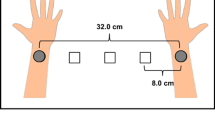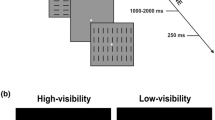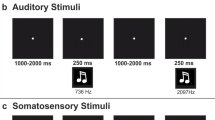Abstract
It is known that perceiving a visual stimulus influences the processing of subsequent somatosensory stimuli. In particular, an emotion-laden visual stimulus influences the processing of types of subsequent somatosensory stimuli. Additionally, visual stimuli approaching the body facilitate spatial and temporal expectations about subsequent somatosensory stimuli even if the visual stimuli do not contain emotional information; however, it remains unclear whether the approach of non-emotional visual stimuli also influences such expectations. To investigate whether the approach of non-emotional visual stimuli influences expectations about types of subsequent somatosensory stimuli, event-related brain potentials (ERPs) during a simple reaction time task using somatosensory stimuli were recorded. Specific colors of visual stimuli and types of somatosensory stimuli were combined to form congruent and incongruent trials. In the congruent trials, specific combinations (e.g., blue color and a single pulse) were presented (80% of the trials), whereas in the incongruent trials, different combinations (e.g., blue color and a train pulse) were presented (20% of the trials). Under the approach condition, the visual stimuli sequentially approached the wrist to which the somatosensory stimulus was presented. In the neutral condition, the visual stimuli did not approach. The results of the ERP analysis showed that incongruence evoked a P3 response with larger amplitude under the approach condition than under the neutral condition. This result suggests that visual stimuli that approach the body function as clues regarding the types of subsequent somatosensory stimuli even if the visual stimuli do not contain emotional information.






Similar content being viewed by others
References
Abrams RA, Davoli CC, Du F, Knapp WH, Paull D (2008) Altered vision near the hands. Cognition 107:1035–1047. https://doi.org/10.1016/j.cognition.2007.09.006
Cohen J (1988) Statistical power analysis for the behavioral sciences, 2nd edn. Lawrence Earlbaum Associates, Hillsdale
Delorme A, Makeig S (2004) EEGLAB: an open source toolbox for analysis of single trial EEG dynamics. J Neurosci Methods 134:9–21. https://doi.org/10.1016/j.jneumeth.2003.10.009
Donchin E (1981) Surprise! … Surprise? Psychophysiology 18:493–513. https://doi.org/10.1111/j.1469-8986.1981.tb01815.x
Duncan-Johnson CC, Donchin E (1977) On quantifying surprise: the variation of event-related potentials with subjective probability. Psychophysiol 14:456–467. https://doi.org/10.1111/j.1469-8986.1977.tb01312.x
Fujisaki W, Nishida S (2009) Audio–tactile superiority over visuo–tactile and audio–visual combinations in the temporal resolution of synchrony perception. Exp Brain Res 198:245–259. https://doi.org/10.1007/s00221-009-1870-x
Gibson J (1962) Observation on active touch. Psychol Rev 69:477–491. https://doi.org/10.1037/h0046962
Greenhouse SW, Geisser S (1959) On methods in the analysis of profile data. Psychometrika 24:95–112. https://doi.org/10.1007/BF02289823
Katayama J, Polich J (1998) Stimulus context determines P3a and P3b. Psychophysiology 35:23–33. https://doi.org/10.1111/1469-8986.3510023
Kekoni J, Hämäläinen H, McCloud V, Reinikainen K, Näätänen R (1996) Is the somatosensory N250 related to deviance discrimination or conscious target detection? Electroencephalogr Clin Neurophysiol 100:115–125. https://doi.org/10.1016/0013-4694(95)00231-6
Kekoni J, Hämäläinen H, Saarinen M, Gröhn J, Reinikainen K, Lehtokoski A, Näätänen R (1997) Rate effect and mismatch responses in the Somatosensory system: ERP-recordings in humans. Biol Psychol 46:125–142. https://doi.org/10.1016/S0301-0511(97)05249-6
Kimura T, Katayama J (2015) Approach of visual stimuli modulates spatial expectations for subsequent somatosensory stimuli. Int J Psychophysiol 96:176–182. https://doi.org/10.1016/j.ijpsycho.2015.04.002
Kimura T, Katayama J (2017a) Regularity of approaching visual stimuli influences spatial expectations for subsequent somatosensory stimuli. Exp Brain Res 235:1657–1663. https://doi.org/10.1007/s00221-016-4863-6
Kimura T, Katayama J (2017b) Visual stimuli approaching toward the body influence temporal expectations about subsequent somatosensory stimuli. Brain Res 1664:95–101. https://doi.org/10.1016/j.brainres.2017.03.030
Lopez-Calderon J, Luck SJ (2014) ERPLAB: an open-source toolbox for the analysis of event-related potentials. Front Hum Neurosci 8:213. https://doi.org/10.3389/fnhum.2014.00213
Luck SJ (2014) An introduction to the event-related potential technique. MIT Press, Cambridge
Mognon A, Jovicich J, Bruzzone L, Buiatti M (2011) ADJUST: an automatic EEG artifact detector based on the joint use of spatial and temporal features. Psychophysiology 48:229–240. https://doi.org/10.1111/j.1469-8986.2010.01061.x
Montoya P, Sitges C (2006) Affective modulation of somatosensory-evoked potentials elicited by tactile stimulation. Brain Res 1068:205–212. https://doi.org/10.1016/j.brainres.2005.11.019
Polich J (2007) Updating P300: an integrative theory of P3a and P3b. Clin Neurophysiol 118:2128–2148. https://doi.org/10.1016/j.clinph.2007.04.019
Ravaja N, Harjunen V, Ahmed I, Jacucci G, Spapé MM (2017) Feeling touched: emotional modulation of somatosensory potentials to interpersonal touch. Sci Rep 7:40504. https://doi.org/10.1038/srep40504
Reed CL, Grubb JD, Steele C (2006) Hands up: attentional prioritization of space near the hand. J Exp Psychol Hum Percept Perform 32:166–177. https://doi.org/10.1037/0096-1523.32.1.166
Sams M, Alho K, Näätänen R (1983) Sequential effects on the ERP in discriminating two stimuli. Biol psychol 17:41–58. https://doi.org/10.1016/0301-0511(83)90065-0
Shaffer JP (1986) Modified sequentially rejective multiple test procedures. J Am Stat Assoc 81:826–831. https://doi.org/10.2307/2289016
Spence C (2002) Multisensory attention and tactile information-processing. Behav Brain Res 135:57–64. https://doi.org/10.1016/S0166-4328(02)00155-9
Spence C (2010) Crossmodal spatial attention. Ann N Y Acad Sci 1191:182–200. https://doi.org/10.1111/j.1749-6632.2010.05440.x
Spence C, Nicholls MER, Gillespie N, Driver J (1998) Crossmodal links in exogenous covert spatial orienting between touch, audition, and vision. Percept Psychophys 60:544–557. https://doi.org/10.3758/BF03206045
Spence C, Pavani F, Driver J (2000) Crossmodal links between vision and touch in covert endogenous spatial attention. J Exp Psychol Hum Percept Perform 26:1298–1319. https://doi.org/10.1037/0096-1523.26.4.1298
Spence C, Shore ID, Klein MR (2001) Multisensory prior entry. J Exp Psychol Gen 130:799–832. https://doi.org/10.1037/0096-3445.130.4.799
Walter WG, Cooper R, Aldridge VJ, McCallum WC, Winter AL (1964) Contingent negative variation: an electric sign of sensorimotor association and expectancy in the human brain. Nature 203:380–384. https://doi.org/10.1038/203380a0
Acknowledgements
Part of this study was supported by Special Research Fund A of 2017 funds from Kwansei Gakuin University awarded to JK. The experiment was conducted as part of the project supported by the Ministry of Education, Culture, Sports, Science and Technology (MEXT), JAPAN, for the Strategic Research Foundation at Private Universities (2015–2019; Project number S1511032) at the Center for Applied Psychological Science (CAPS), Kwansei Gakuin University.
Author information
Authors and Affiliations
Corresponding author
Ethics declarations
Conflict of interest
The authors declare that the research was conducted in the absence of any commercial or financial relationships that could be construed as a potential conflict of interest.
Rights and permissions
About this article
Cite this article
Kimura, T., Katayama, J. The approach of visual stimuli influences expectations about stimulus types for subsequent somatosensory stimuli. Exp Brain Res 236, 1563–1571 (2018). https://doi.org/10.1007/s00221-018-5244-0
Received:
Accepted:
Published:
Issue Date:
DOI: https://doi.org/10.1007/s00221-018-5244-0




